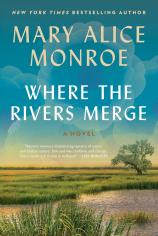Reading Group Guide
Discussion Questions
Where the Rivers Merge

1. WHERE THE RIVERS MERGE begins not within the stately halls of Mayfield, but in the belly of a great oak on Mayfield land. Why is Eliza drawn to this sanctuary? In the novel, Eliza thinks, “A sanctuary is a haven of refuge. People tend to find such places in time of need.” What does taking refuge mean in this novel? How is the oak tree similar to Mayfield for her? Has there been a place of refuge in your own life?
2. Eliza expresses her love for Mayfield through her enduring desire to protect it, both as a willful young girl and as a fierce woman. How does love for a place differ from love for a person? How is protecting a place different from protecting a person?
3. The author begins each chapter with information about wildlife, plants and geographical features of South Carolina. How do these interact with the narrative’s tone, themes and plot? What do you think these epigraphs add to the story?
4. One of the central features of Mayfield’s house is the large mural in the dining room. Eliza uses this mural as a lens through which to share Mayfield’s history with the next generation of women. What scenes would be depicted in your own mural?
5. Birds play an integral role in the narrative. Covey’s name means “a small flock,” or “company, group.” In the letters Hugh and Heyward send to Eliza and Covey, they write of the birds they encounter. As children, these characters are brought together by the bird hospital established by Wilton. In what ways do the birds in WHERE THE RIVERS MERGE represent the characters and their relationships?
6. In a moment of desperation, Eliza tells a secret that is not hers to share. How did her decision make you feel? How did it change the course of the story? Have you ever been confided in by someone whose secret was not theirs to share, and how did this change your relationships?
7. The threat of the Jim Crow South is a constant throughout the novel, in Charleston and also at Mayfield. How does that impact the relationship between the two women friends, Covey and Eliza? Discuss how Eliza, a white character, could not fully understand what Covey, a Black character, faced in terms of threats and worries.
8. WHERE THE RIVERS MERGE examines the power, pain and sacrifice of belonging to and upholding family lineage. How do race and gender identity affect the agency of characters in the novel? What do the families in the novel reveal about what it means to carry on a legacy?
9. Primogeniture is the right of succession belonging to the firstborn child, in which the whole real estate of a deceased parent is passed to the eldest son. Primogeniture was not a legal principal in the United States at the time of the novel, but some of the landed gentry, such as the Rivers, still held to it. By concentrating inheritance in the hands of the eldest son, primogeniture prevents the division of land and property into smaller parcels over generations. This can help maintain the economic viability and influence of the estate. Discuss the pros and cons of primogeniture in feudal and modern times.
10. Eliza at 88 years of age had faced a lifetime of being thwarted because of her gender. From childhood chores to women’s political rights, social expectations and later business, we see the toll it took on the woman. Discuss the difference between the free-spirited young girl and the hardened, even cold old woman we met at the beginning of the book. As Eliza tells the stories of her youth, did you witness the melting of the ice as connections are made with the two young women and hope begins to stir? Discuss the subtle changes in Eliza through the story and the power of memories and family support to shift emotions.
11. Norah and Savannah each has her own issues and reasons for deciding to come to Mayfield. Discuss these women and how the stories they are hearing of their ancestors might change their relationship with Eliza, Mayfield and each other. How do the stories of our past, even our genetic memory, influence us? Does your family share stories of previous generations?
Where the Rivers Merge
- Publication Date: May 13, 2025
- Genres: Fiction, Historical Fiction, Women's Fiction
- Hardcover: 352 pages
- Publisher: William Morrow
- ISBN-10: 0063249421
- ISBN-13: 9780063249424







